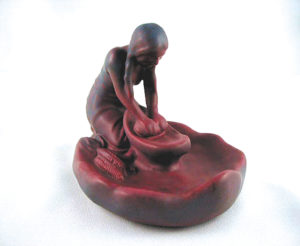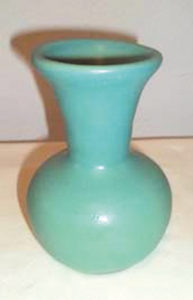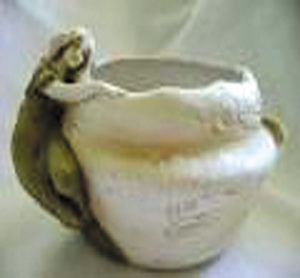 By Ann Brandt
By Ann Brandt Artus Van Briggle lived only 35 years, but he left behind an artistic legacy. Van Briggle has been called a genius, an artist and a potter. He was all those things, working with intensity, fueled in the last five years of his life by the knowledge of impending death from tuberculosis.
Before Van Briggle’s work became widely known, most art pottery was finished with a high gloss and colorful decorations, in the Victorian fashion of ornate design. That style changed toward the end of the nineteenth century with the advent of Art Nouveau when European artists and architects began exploring a new and modern type of art. Van Briggle was a key figure in bringing the concept of Art Nouveau to the United States. The satin sheen, the softened and curved designs, and motifs drawn from things of nature and legend make a Van Briggle piece unique in art pottery.
After serving an apprenticeship at Avon Pottery in Ohio and continuing art studies at the Cincinnati Art School, Artus worked at Rookwood Pottery Company. In 1893 the company sent him to Paris where he lived for three years, attending art classes and studying the work of old masters. There, he became interested in Oriental potteries, visiting museums and admiring the dull gloss glaze of ancient art works. Fascination with the “dead glaze” used during the Ming Dynasty of 1368 to 1644 would lead Van Briggle into a lifelong task of rediscovering and perfecting a recipe for the unique glaze that collectors recognize in a Van Briggle piece.
 A catalyst to the creation and success of Van Briggle’s work was the Arts and Crafts movement. During the mid 1800s to the early 1900s, the industrial revolution and its mass production of goods and materials stimulated many artists and craftsmen to greater efforts in handcrafting beautiful things for a wide market. Art Nouveau (new art) in America grew out of the American Arts and Crafts movement with its emphasis on simplicity of design and good craftsmanship.
A catalyst to the creation and success of Van Briggle’s work was the Arts and Crafts movement. During the mid 1800s to the early 1900s, the industrial revolution and its mass production of goods and materials stimulated many artists and craftsmen to greater efforts in handcrafting beautiful things for a wide market. Art Nouveau (new art) in America grew out of the American Arts and Crafts movement with its emphasis on simplicity of design and good craftsmanship. The final event that put into place the creation of Van Briggle Art Potteries occurred in Artus’s relocation to Colorado Springs in 1899 when his failing health indicated need for a dry climate. On the advice of his doctor, Van Briggle began taking long walks in canyons in and around the Garden of the Gods. Using clays from that region as well as imported clays he continued mixing and firing with experimental glazes until he had brought back to life the Ming glaze. During the summer of 1900, Van Briggle’s first exhibit of the dead glaze was held at the Paris Exposition. By the time he arrived in Colorado, he had won silver and gold medals for his work in Paris. Just months before his death, he won six medals at the 1904 St. Louis Exposition.
In December 1901, the first public display and sale of Van Briggle art pottery resulted in a sell-out of all 300 pieces. The pottery company was formally established in February 1902 in a small workshop with one assistant. That year Artus married Anne Lawrence Gregory whom he had met while studying in Paris years before. Together they worked out the Van Briggle logo—a double A inside a square that continues to be used and is found on virtually every piece of Van Briggle.
 After Artus died in 1904, Anne became president of the company and continued to run the expanding pottery for an additional eight years. In 1910, financial problems contributed to a company reorganization and renaming-the “Van Briggle Pottery and Tile Company. Following a series of ownership changes, natural catastrophes, and financial troubles, the pottery moved in 1955 to the Midland Terminal Roundhouse near U.S. Highway 24 where it is owned and run by Craig Stevenson who is also in charge of the Van Briggle Art Pottery design work.
After Artus died in 1904, Anne became president of the company and continued to run the expanding pottery for an additional eight years. In 1910, financial problems contributed to a company reorganization and renaming-the “Van Briggle Pottery and Tile Company. Following a series of ownership changes, natural catastrophes, and financial troubles, the pottery moved in 1955 to the Midland Terminal Roundhouse near U.S. Highway 24 where it is owned and run by Craig Stevenson who is also in charge of the Van Briggle Art Pottery design work. Artus had developed a process for making tiles just before he died and it is said that Anne sketched out the designs for the tiles. Art tiles continue to be a part of the company line. The older tiles are quite expensive, running up to $600 for one tile. No one knows the exact number of older homes in Colorado Springs containing fireplaces decorated with Van Briggle tiles; estimates range from two dozen to two hundred. Now, tiles produced at the pottery are considered an economical way to begin a Van Briggle collection, and groups touring the pottery might enjoy the opportunity of hand pressing a tile. New collectors purchase the tiles to use as trivets or hot pads for the dining table.
In addition to tiles, vases, and bowls, the pottery produces figurals, works in which a figure is an integral part of the overall design. The Lorelei, which is based on the famous legend of the lady on the Rhine River luring sailors to their death, is one of Artus’s first and most famous designs. Values on the Lorelei vary from $875-$1,025 for a piece from the 1920s to $125 to $325 for a piece produced in the late 1980s. The original Lorelei is in the Louvre.
The Chalice Cup—sometimes called the Toast Cup—is another of the most famous creations, with a price of $6,500 to $8,000. Designed by Artus in 1900 and produced in the 1920s the original is found in the Colorado Springs Pioneer Museum.
Another famous Van Briggle is Despondency, depicting a man curved around and blended into the top of a large vase. This design is thought to have been conceived while Artus was reflecting on his impending death. It was purchased by the Louvre for $3,000 after it won first prize at the Paris Salon exhibit. However, you can purchase a new Lorelei or Despondency for under $200.
Lamps with the distinctive butterfly-pattern shades have been a part of the Van Briggle line also, varying in price from $75 for a lamp from the 1980s until the present to over $400 for older lamps. You can look for Van Briggle creations on e-bay, at auctions, or at art shows. Vases, bowls, and figurals sometimes appear at garage sales, often when the seller does not realize the full worth of the piece. However you acquire a Van Briggle piece, it will grow in value.
Artus wanted his art pottery to mirror the colors of the Colorado landscape: the brilliant turquoise of the sky, the reds, grays, browns, yellows, blues, and purples that exist in striking contrast in Colorado’s mountain canyons, and in the subtle tones of dawn and twilight on the plains. Especially charming are the pieces that show a blend of colors.
The glaze colors in Van Briggle art pottery have varied through the years. From 1912 until the 1920s, Turquoise Blue or Ming Turquoise, Mulberry, and Mountain Craig Brown glazes were used. Persian Rose, a lighter maroon than Mulberry, was used from 1946 to 1968. Other colors included Moonglo, Honey Gold, Jet Black, and Trout Lake Green. From 1970 until the present, Ming Turquoise as well as variations of Moonglo, Russet, Midnight, and other colors appear in Van Briggle creations.
Determining the date of production in a particular piece, especially pottery produced after 1920, is difficult for beginning collectors. Experienced collectors look at the color of the clay, bottom glazing, glaze color and type of lettering. All Van Briggle is signed with the company logo—the double “A” inside a square.
Today, the pottery continues under the name of its founder. Stevenson once said that Artus could walk in now, start working, and feel right at home; the techniques that he instituted have not changed. A group of dedicated artists and craftsmen continues the work that brought Art Nouveau from Europe to the United States and made it ours.
SIDEBAR Sasicki, Richard and Josie Fania, The Collector’s Encyclopedia of Van Briggle Art Pottery, Collector Books, Kentucky, 1993. The book contains extensive information on identification and dating. Raga, David and Suzanne Perrault, Miller’s: How to Compare & Value American Art Pottery: www.amartpot.org American Art Pottery Association — an online interchange of information, opinion, and comments on the art pottery scene. www.vanbriggle.net The Van Briggle Pottery Collectors Network.















Follow Us